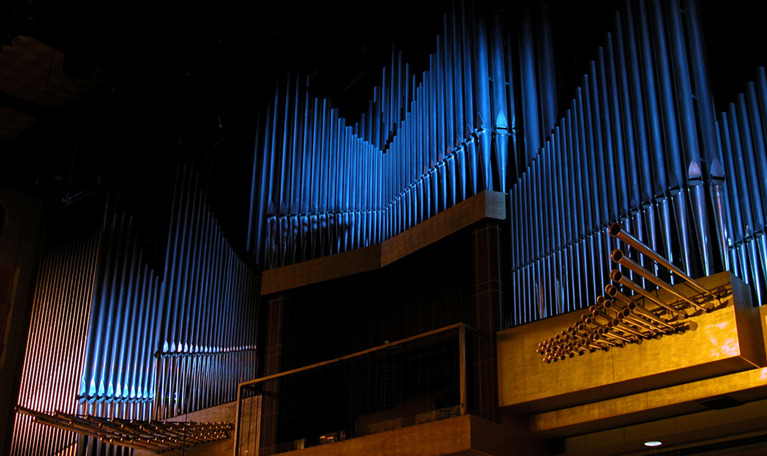The organ

Photo: Jan-Olav Wedin
Grönlunds Orgelbyggeri in Gammelstad were granted the honourable task of constructing the organ, using the organ in Amsterdam’s Concertgebouw as a model for the sound. Over the years, the modern era’s leading organists have performed at Konserthuset Stockholm, including Marie-Claire Alain, Olivier Latry, Susan Landale, Carlo Curley, Werner Jacob and Gustav Leonhardt.
Konserthuset’s organs – a bit of history
Konserthuset Stockholm opened on 7 April 1926. The group that planned the building had several requirements for the Main Hall. The stage should be able to hold an orchestra of 100 and a choir of at least 150 people. By the stage, there should be room for a large organ with its facade facing outwards.
In the end, Ivar Tengbom won the architectural competition. He had his own thoughts on the visual design of the organ, which he later presented in the leaflet that was published for the opening. “The Main Hall is designed so that the audience seating area and the stage are one room, united by a single cornice. The orchestra seats are surrounded by walls from which the tall, light columns rise in front of the open porticoes [Editor’s note: covered colonnade, loggia, vestibule with columns], in which the first and second rows are inset. The stage is surrounded by more closed walls, but with openings for access to the sounds of the organ. The organ is built into the spaces behind these walls. To give these sound openings an architectural form, while avoiding the visual of an organ facade, which would disturb the overall impression of the space, inside the back wall of the stage is a decorative device, which was often used in the past, known as a ‘forced perspective.’”
Konserthuset Stockholm’s first organ
The old organ gradually began to develop problems. The instrument was built by the company Åkerman & Lund, which had the unfortunate task of positioning the organ behind the walls surrounding the stage, with half of the organ on the right side and half on the left. The sound was muffled and lacked clarity, even though the organ had over 90 pipes. It also had a noticeable delay, which created problems when playing with the orchestra; Otto Olsson pointed this out after the organ’s inaugural concert on 6 October 1926.
Gustaf Hägg and Oskar Lindberg sketched the organ based on input from the renowned contemporary Italian organ virtuoso, Enrico Bossi (1861–1925), who had previously performed in Sweden.
The fate of Konserthuset Stockholm’s first organ is not an uplifting tale. Despite cosmetic efforts (cleaning, tuning, electrical repairs etc.), the instrument never quite won over either audiences or organists, and in the summer of 1970, it was disassembled and stored in Hammarbyhamnen, where it was kept until 1979, when some parts were reused for the new organ.
The 1970s: a temporary fix and faith in the future
The Main Hall underwent extensive renovations in the early 1970s, but when it reopened on 26 January 1973 with Mahler’s Symphony No. 8, conducted by Antal Dorati, the organ part was played on an electric Yamaha organ, the unbearable sound of which most closely resembled a summertime swarm of mosquitos in Norrland. This temporary fix had to suffice for the rest of the 1970s, but behind the scenes, extensive preparations were underway for a large concert organ.
In 1976, the board granted the Executive and Artistic Director at that time, Bengt Olof Engström, permission to appoint a committee to look into the matter of a new organ. The project was called “Organ 80”. An organ committee was formed, consisting of Bengt Olof Engström, Gotthard Arnér, Karl-Erik Welin, Erik Lundkvist and organ-maker Stig Magnusson, who worked intensively with various suggestions. On 4 December 1978, the board of the Stockholm Concert Hall Foundation received a quote from Grönlunds Orgelbyggeri in Gammelstad (in stiff competition with the firms Klais and Rieger). The cost was estimated at SEK 7.2 m, and the project would be finished by February 1982.
With unyielding energy, creativity, and patience, and unwaning faith in the project, Executive and Artistic Director Bengt Olof Engström pushed through the organ project, supported strongly by the board and its chair, Erland Waldenström, and vice chair Bertil Åberg. Konserthuset Stockholm’s new organ was built during a financially difficult time and how they managed to fund the construction of this expensive instrument is admirable. The organ became a matter of national importance. It could be funded by the state and municipality, but a fundraising project also brought in a considerable sum. For SEK 1,000, donors could have their names engraved on their pipe of choice, and many individuals and companies met the challenge. The pipe donors’ names were published in a special publication and included members of Sweden’s business and cultural communities, as well as many others.
The organ today
Konserthuset Stockholm’s organ, with its magnificent facade designed by architect Anders Tengbom, seems to be – at least visually – one of Europe’s best-known organs (not least because the facade is broadcast on TV each year in conjunction with the Nobel festivities). The instrument has 69 pipes divided into four manuals and pedals. The main division (Manual II) has 19 pipes, including five trumpet registers, two of which are “single chime”, in reference to the horizontal layout of the pipes, known as “Spanish trumpets”. The swell division (Manual III) is the biggest division of the organ and is placed due to its size on two wind chests on either side of the main division. It has 20 pipes. The positive, which is played from Manual I, has eleven pipes and Manual IV, the solo division, has four high-pressure pipes. The pedal division has 15 pipes. In total, there are 6,100 pipes. Some of the pipe material was reused from the old organ, but a significant amount had to be added. The organ’s largest pipe is about 10 metres; the diameter for note C in Principle 16’ measures 300 mm.
The wind supply comes from five blowers, including a high-pressure blower. The organ has two keyboards, one of which is affixed to the organ, while the other can be moved to the stage. The tonal range is C-c4 for the manuals and C-g1 for the pedals.
The fixed keyboard is built with a mechanical tract for the main division, positive, and swell division. The pedal and solo divisions are equipped with electropneumatic transfer. The mobile keyboard only has electronic functions, and the registers are in the same positions as the fixed keyboard. When playing, the feel is similar to the mechanical keyboard, but somewhat lighter and without pressure points.
The electromechanical controls were replaced with a digital system in a 2008 renovation. The new system makes things easier for the organist because it can store more sound combinations (20,000 rather than the previous 16) in one combination system. The combination system also enables more organists to store their own settings independently of one another. The new system also makes it easier to manage and maintain the organ.
The intarsia woodwork in the keyboard is made with jacaranda, walnut, and maple. The keys are coated with ivory and ebony. Both keyboards have both radial and parallel pedalboards that can be placed in two positions.
Prominent guests
Since its debut on 9 February 1982, Konserthuset Stockholm’s organ has been played by leading contemporary organists, such as Marie-Claire Alain, Simon Preston, Edgar Krapp, Gustav Leonhardt, Thomas Trotter, Olivier Latry, Werner Jacob, Susan Landale, Keith Chapman, Gillian Weir, Jane Parker-Smith and Sweden’s foremost organists. Composers such as Siegfried Naumann, Lars-Erik Rosell, Anders Nilsson, Torsten Nilsson, Hans Holewa, Lars Edlund, Jan W. Morthenson and Bengt Hambræus have written works specifically for Konserthuset’s organ.
Text: Erik Lundkvist, Konserthuset Stockholm’s organist from 1971–2012. Lundkvist, together with the Executive and Artistic Director at the time, Olof Engström, participated in the construction of Konserthuset Stockholm’s organ.
